The League of Extraordinary Minds for Schools
Powerful support for teachers in teaching information technology.
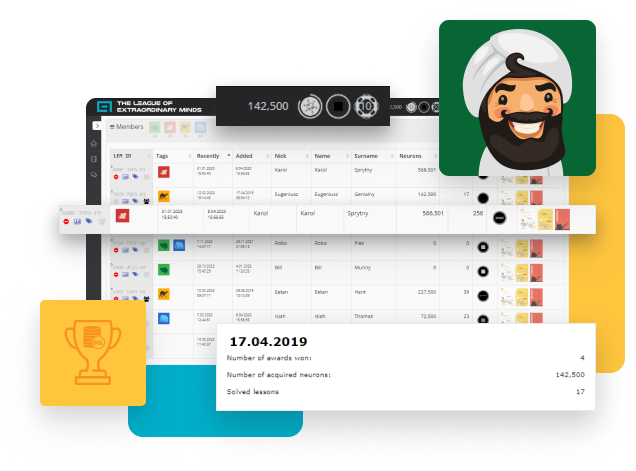
WHAT YOUR SCHOOL WILL GAIN WITH LEM
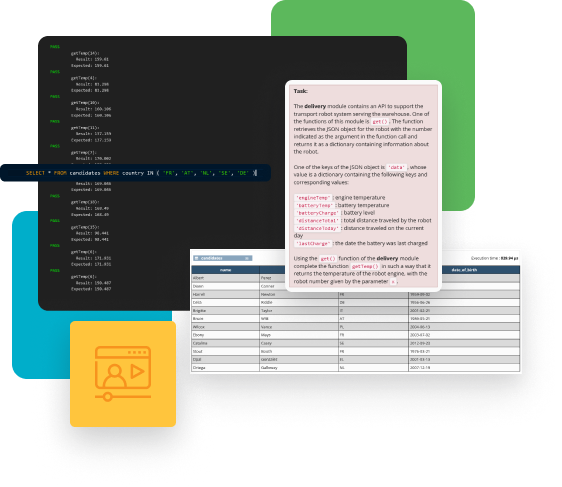
LEARNING IT THROUGH PRACTICE AND SOLVING PROBLEMS
Learning on the LEM platform consists in solving programming tasks in practice, i.e. creating real source code or queries to databases. The platform interface includes a development environment that allows you to edit the source code file and run your programs. Each lesson consists of an introduction to a specific topic and a problem that needs to be solved by creating a program or – in the case of SQL – by querying a database.
If your students encounter difficulties in solving a problem, they can use the hint, and if it turns out to be insufficient they can ask for help from a consultant via the contact form. Teachers also have access to a special tab with an exemplary, correct solution to a task in order to be better prepared to work with students and be able to help them.




of students using LEM pass certification exams based on the e-CF European E-Competence Framwork.
SCHOOL PACKAGES
 IT Club | 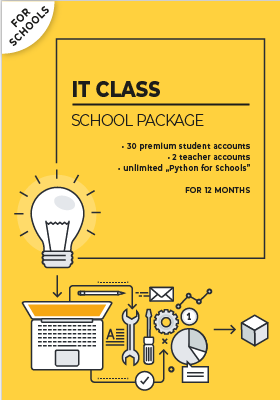 IT Class |  IT School | |
|---|---|---|---|
Number of accesses | 15 | 30 | 300 |
Teacher accounts | 2 | 4 | 10 |
Python Level 1 | YES | YES | YES |
SQL Level 1 | YES | YES | YES |
SQL Level 2 | YES | YES | YES |
+ Python for schools | No limits | No limits | No limits |
Duration | 12 months | 12 months | 12 months |
Price | $699 | $949 | – |
Number of accesses |
Teacher accounts |
Python Level 1 |
SQL Level 1 |
SQL Level 2 |
+ Python for schools |
Duration |
Price |
 IT Club |  IT Class |  IT School |
|---|---|---|
15 | 30 | 300 |
2 | 4 | 10 |
YES | YES | YES |
YES | YES | YES |
YES | YES | YES |
No limits | No limits | No limits |
12 months | 12 months | 12 months |
$699 | $949 | – |
Details of courses included in packages
-
Python for schools
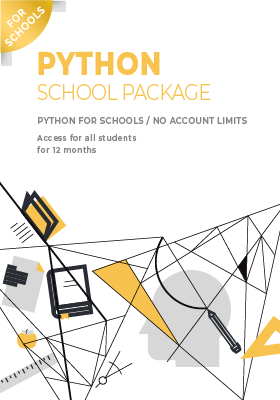
The course based on the core curriculum of the subject of computer science in the part related to elements of programming and solving problems with the use of a computer. The course is adapted to the abilities of an average student, with a ready set of tasks to be carried out at school during lessons with all students, as well as tasks to be completed at home by students. Full access to the solutions to the tasks and student work statistics for the teacher.
11 modules1,5h Output statements- Comment
- print() – display string
- print()
- print() – more arguments
- print() – display the number
- print() – arguments of different types
1h Arithmetic operations- Addition
- Subtraction
- Multiplication
- Division
- Integer division
- Remainder from division
- Exponentiation
1h Variables- Creating variables
- Variable names
- Variables in expressions
- Values of different types
- Variables – exercise
3,5h Functions- Functions
- Calling the function 1
- Calling the function 2
- Your function
- Function parameters 1
- Function parameters 2
- More parameters
- More calls
- The function returns … the value
- Functions – tests
- Function speed()
- calcArea() function
2h Conditional statements- Comparison operators
- Logical operators and & or
- if – conditional statement
- Checking the range
- The else clause
- elif clause
- Air purifier
- Triangles
1h while loop- while loop
- Tennis ball machine
- Shortened operators
- Alphabet
2,5h Sequences: strings- Indexing
- Concatenating
- len() function
- Exercise: check your ID number
- Slicing the sequence
- Exercise: year
- Non-mutability
- The index() method
- in operator
- The count() method
2h for loop- for loop
- Exercise: add $
- Exercise: duplicate
- Exercise: distribution
- The range() function 1
- The range() function 2
- The range() function 3
- Indexing with range()
1,5h Sequences: tuples- Tuples
- Exercise: return the tuple
- Exercise: first quarter
- Exercise: character generator
- Concatenation and slicing
- Iterating through tuple
- More expressions in return
3h Sequences: lists- Lists
- Indexing
- Exercise: shot
- Concatenation and slicing
- Iterating through the list
- Adding elements
- Exercise: queue
- Inserting items
- Deleting elements: del()
- Removing elements: remove()
- Exercise: audience
- Exercise: collections
2,5h Data type and conversion- Data type
- Exercise: year
- Float type
- Exercise: average time
- string type
- Exercise: numbers
- bool type
- Exercise: add six months
-
Python Level 1
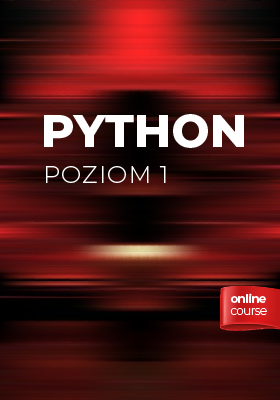 7 modules4h Variables and strings
7 modules4h Variables and strings- Comments
- Exercise – commentary
- The print() function
- Exercise – print()
- Expressions
- Arithmetic operators
- Exercise – Baguettes
- print() – several expressions
- Exercise – Sausages
- Exercise – modulo
- Variables
- Exercise – students
- Methods
- lower()
- capitalize()
- title()
- replace()
- swapcase()
- strip()
- Concatenation
- Exercise – name and surname
- String multiplication
- The “sep” parameter
- The “end” parameter
- Combo
5h Functions- And now for something completely different
- Function definition
- Calling the function
- Exercise – self congrats
- And now for something completely different
- Exercise – one more function
- Exercise – and one more ..
- Parameters or para-meters?
- The string as an argument
- More parameters
- And now for something completely different
- The function returns a value
- Once again the function returns a value
- Exercise – Ole!
- Return ends function
- Tasks with tests
- Exercise – Celsius to Fahrenheit
- Exercise – gallons per liter
- Exercise – perimeter
- Exercise – area
- Using the function
- Exercise – time 1
- Exercise – time 2
- Exercise – gross
- QUIZ
5h if & while- Comparison operators
- Logical values
- Logical operators
- The if statement
- Scope
- The else clause
- elif clause
- Exercise: days of the week
- Exercise: even
- Exercise: set the valve
- Air purifier
- Exercise: alarm installation
- Exercise: Triangles
- While loop
- Exercise: Hail to the president!
- Exercise: compressor
- Exercise: tennis machine
- Exercise: corridor
- Short operators
- Exercise: debt
- Exercise: bet
6h Sequences part 1- Indexing
- Exercise: display character
- Function len()
- Exercise: length difference
- Slicing the sequence
- Exercise: Cut a year
- Immutability
- The index() method
- Exercise: initials
- Operator in
- Exercise: clear
- The count() method
- Exercise: sign participation
- for loop
- Exercise – vowels
- The ord() function
- The chr() function
- Exercise – decrypt
- The range() function
- Exercise: a bit more difficult code
- range() – two arguments
- range() – three arguments
- Exercise: Odd characters
6h Sequences part 2- The isalpha() method
- The isnumeric() method
- The isalnum() method
- Modules
- Exercise: time
- Tuples
- Exercise – the longest string
- Sequence concatenation
- Exercise: Chinese days *
- The function returns more values!
- Lists
- The sorted() function
- The sort() method
- Exercise: highest and lowest
- The append() method
- The max() and min() functions
- The sum() function
- The insert() method
- Exercise: a diving competition
- The del() function
- The remove() method
- The List function()
- Copying the list
- The reverse() method *
- Slicing with a shift
- Exercise: the ananyms
- The nested sequences
- Exercise: a maximum temperature
4,5h Casting, sets and dictionaries- Type casting
- String method: split()
- Input() and round() functions
- Exercise: working days
- Collections, set()
- The add() method
- Remove() and discard() methods
- Clear(), copy() methods, comparison of sets
- Sets union
- Common part of the collection
- Interpol 1
- The difference of sets
- Symmetrical difference
- Dictionaries
- Value change
- Adding a new dictionary element
- Deleting items
- The fromkeys() method
- Methods: keys(), values(), items()
- Sets methods
- Exercise: count the characters
- Exercise: delivery robots
- Exercise: sum of routes
- Exercise: charging
- Exercise: jam on the rout
5,5h Exceptions and working with files- Working with text files
- The read() method plus bytes
- The readline() method
- The readlines() method
- Iterating by rows
- Exercise: find a person
- Write to a file: write()
- The writelines() method
- Exercise: women’s data
- Adding data to a file
- Read / write modes
- Exercise: elements
- The seek() method
- Exercise: swap characters
- Exercise: Your data
- Exception handling: try … except
- Exercise: quotient
- Exception types
- Exercise: particle detector
- else i finally
- Exercise: ASCII message
- Raising exceptions: raise
- Raising exceptions: assert
- Quiz
-
SQL Level 1
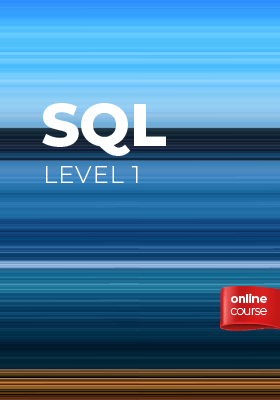 5 modules0,5h Introduction
5 modules0,5h Introduction- Introduction to databases
- Databases Management Systems
- What is it SQL
- SQLite
2h SELECT clause- SELECT
- Exercise – movies 1
- Keywords
- Exercise – movies 2
- Data from all columns
- DISTINCT 1
- DISTINCT 2
- ORDER BY / ASC
- Exercise – titles of fairy tales
- Exercise – movie titles
- DESC
- Exercise – cell phones 1
- Exercise – tails
- LIMIT / TOP
- Exercise – cell phones 2
- Exercise – cell phones 3
- Exercise – rating 1
- Exercise – rating 2
3,5h WHERE clause- WHERE clause
- Exercise – 21st century cats
- Exercise – cell phones 4
- AND operator
- Exercise – cell phones 5
- Exercise – SF
- Exercise – cell phones 6
- BETWEEN operator
- Exercise – scope
- OR operator
- Exercise – Scott brothers
- Exercise – cell phones 7
- IN operator
- Exercise – Drama
- IN – data from another table
- Exercise – favorite movies
- NOT IN
- Exercise – NOT favorite movies
- Operator LIKE
- Exercise – the third from the end
- Exercise – Tom Cruise
- Exercise – Eastwood & Freeman
- Exercise – actor and director
- Exercise – Dire Ctors
- NOT LIKE
- Exercise – titles
- Exercise – cats without ‘r’
- Exercise – combo movies
5h Let's count!- MAX() & MIN()
- Exercise – the longest tail
- Exercise – cheap cell phone
- Exercise – screen
- COUNT()
- Exercise – ratings range
- Exercise – black cell phones
- Exercise – count the brands
- AVG()
- Exercise – average grade
- Exercise – average price
- Exercise – good movies
- SUM()
- Exercise – tickets
- Exercise – Fletcher Reede
- GROUP BY
- Exercise – models of all brands
- Sorting groups
- Aliases
- Exercise – the cheapest models
- Exercise – fines in the cities
- HAVING
- Exercise – big ticket “catchers”
- Arithmetic operators
- Exercise – price / screen ratio
- Exercise – even better movies
- Exercise – DARPA 1
- Modulo
- Exercise – DARPA 2
- Exercise – DARPA 3
- Connecting strings
4h Table management- Deleting tables
- Exercise – orders
- Creating tables
- Data types
- Constraint NOT NULL
- Constraint DEFAULT
- Constraint CHECK
- Exercise – Barbie hair
- Key table
- Exercise – vinyls 1
- AUTOINCREMENT
- Exercise – the key for Barbie
- Constraint UNIQUE
- ALTER TABLE – RENAME TO
- Exercise – Vinyls 2
- ALTER TABLE – ADD COLUMN
- Exercise – Barbie’s name
- DELETE FROM – deleting records
- Deleting selected records
- Exercise – Clint
- ORDER BY and LIMIT in DELETE
- Exercise – DARPA 4
- Exercise – 13th post
- INSERT
- Exercise – traffic police
- Exercise – talented Miss Ripley
- Apostrophe in the text
- Adding multiple records
- Exercise – new Barbie
- UPDATE
- Exercise – correction of tickets
- Exercise – uppercase
- Exercise – cell phones correction
- Quiz
-
SQL Level 2
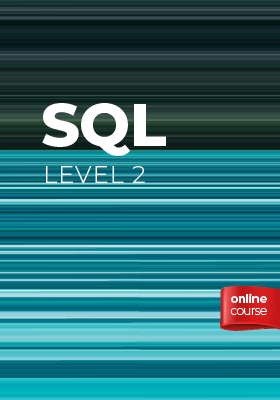 5 modules5h More about numbers
5 modules5h More about numbers- Types and literals
- Integer expressions
- Exercise – 7 UP
- Exercise – temperature
- CAST() – type casting
- Exercise – Jai Alai
- Exercise – crimes per capita (wards)
- Rounding results
- ROUND() – default parameter
- Exercise – average prices
- Exercise – cats in NY
- Exercise – African population
- Exercise – crimes per capita (districts)
- ABS() – absolute value
- Exercise – average expenses
- Exercise – pressure change
- Exercise – DARPA 5
- RANDOM() – random numbers
- Random number range 1
- Range of random numbers 2
- Example – a random movie
6h More about strings- I like LIKE
- ESCAPE
- LIKE () function
- LIKE () function – third parameter
- The LIKE is not enough
- GLOB
- GLOB – several values
- Exercise – [abc]
- Exercise – special characters
- GLOB – scope
- GLOB – connecting wildcards
- Exercise – passwords
- GLOB – [^ ] i NOT
- DARPA 6
- Exercise – table valves
- GLOB() function
- TRIM() function
- Exercise – titles
- TRIM() – default value
- LTRIM() i RTRIM()
- The LENGTH() function
- Exercise – long description
- Exercise – Tate brochure
- SUBSTR() function
- SUBSTR() function – continuation
- Exercise – date
- REPLACE() function
- Exercise – Sci-Fi on SF
- Exercise – SN correction
- UPPER() function
- Exercise – number of tests
- LOWER() function
- INSTR() function
- Exercise – initials of directors
- CHAR() function
- Exercise – dollars to euro
5,5h Joining tables part 1- Have fun with two tables
- Cartesian product
- Match the fairy tale
- We combine the tables
- Relationship
- Exercise – authors of fairy tales
- Internal joints
- Enjoy JOIN
- INNER JOIN
- Exercise – tickets
- Exercise – cars
- NATURAL JOIN
- Exercise – my grades
- USING
- Exercise – jai alai
- CROSS JOIN
- Combining multiple tables
- Exercise – credentials
- JOIN & …
- Exercise – the sum of fines
- Exercise – books of the world
- More about sorting
- Exercise – disloyal authors
6h Joining tables part 2- Outer joins
- LEFT JOIN part 1
- LEFT JOIN part 2
- Exercise – all authors
- Exercise – all drivers
- RIGHT JOIN
- Exercise – film ratings
- Exercise – number of publishers
- Aliases for tables
- SELF JOIN
- Exercise – better movies 1
- Exercise – better movies 2
- UNION part 1
- UNION part 2
- UNION part 3
- Exercise – the most expensive sets
- Exercise – inflows and expenses
- Exercise – good and bad
- Exercise – safe & dangerous
- UNION ALL
- Exercise – moveis in total
- INTERSECT
- Exercise – drivers and owners
- EXCEPT
- Exercise – unusual fairy tales
- FULL OUTER JOIN
4,5h A few additional techniques- CASE statement
- Exercise: days of the week
- CASE, a decisive clash
- Exercise: film-fan’s recommendations
- Exercise: tendency
- Exercise: gender of employees
- IS NULL / IS NOT NULL
- Exercise: middle name
- IFNULL() function
- Exercise: Interpol 1
- COALESCE() function
- Exercise: contact details
- NULLIF() function
- Exercise: Interpol 2
- Optimization of queries
- Table indexing
- Exercise: create indexes
- Exercise: we optimize
- Deleting indexes
- SQLite Master
- Explain Query Plan
- Exercise: analysis

Wykup dostęp do platformy wykorzystując środki na doskonalenie nauczycieli
Lorem ipsum dolor sit amet, consectetur adipiscing elit. Suspendisse quis orci quam. Vestibulum ante ipsum primis in faucibus orci luctus et ultrices posuere cubilia curae; Curabitur viverra vehicula feugiat.
Mauris non molestie libero. Curabitur dictum velit quam, in accumsan libero bibendum vel. Curabitur nulla dolor, tempus eu porta ut, rutrum in tortor. Nunc velit dui, sollicitudin eu faucibus quis, dictum sed tellus. Maecenas semper condimentum eros in ultrices.
The LEE teaching platform provides comprehensive support for schools
FREQUENTLY ASKED QUESTIONS
-
Is the LEM account paid?
Registration and having an account on the platform are completely free of charge. Only access to full versions of individual courses is paid.
-
Are LEM courses only for students?
No, the courses on the platform are for practical learning of programming and are intended for anyone interested, including adults! The offer for schools includes special courses designed to be used at school in IT lessons, based on the current core curriculum and adapted to the abilities of an average student. Other courses are designed for anyone of any age who would like to learn programming, working with databases or other information technologies from scratch.
-
Are school courses at LNU intended for primary schools?
School courses are designed to teach programming in accordance with the core curriculum of the subject of computer science. Since the courses are based on professional programming languages, they are addressed to students from grade 7 of primary/secondary schools (depending on educational system in your country) and all grades if high schools. Naturally, the teacher can also make the courses available to younger students who are interested in programming!
-
Can teachers create accounts for their students?
Accounts on the platform are individual and belong to individual people, so each user – including students – should register an account on their own and not entrust login details to anyone. Teachers have special permissions on the platform that allow them to connect individual student accounts to the school account, which allows them to work together in a group.
-
I bought the course, when will I get access to it?
If you have purchased a course on our website, you have been sent a message with an activation code. Log in to your account and use the code in the “Activation code” field, which you will find in the “My Account” tab after clicking this option in the menu in the upper right corner of the screen. Using the code will unlock access to the course. If you purchase a course directly on the platform, access is activated immediately after payment. Please note that in most courses you have to complete the tasks sequentially, so you can only open the first lesson at the very beginning. Subsequent lessons will be unlocked along with your progress in solving the preceding lessons.
-
I have zero sense of humor. Can I still use the platform?
Of course you can try, but it will be hard. We suggest using the free version first.